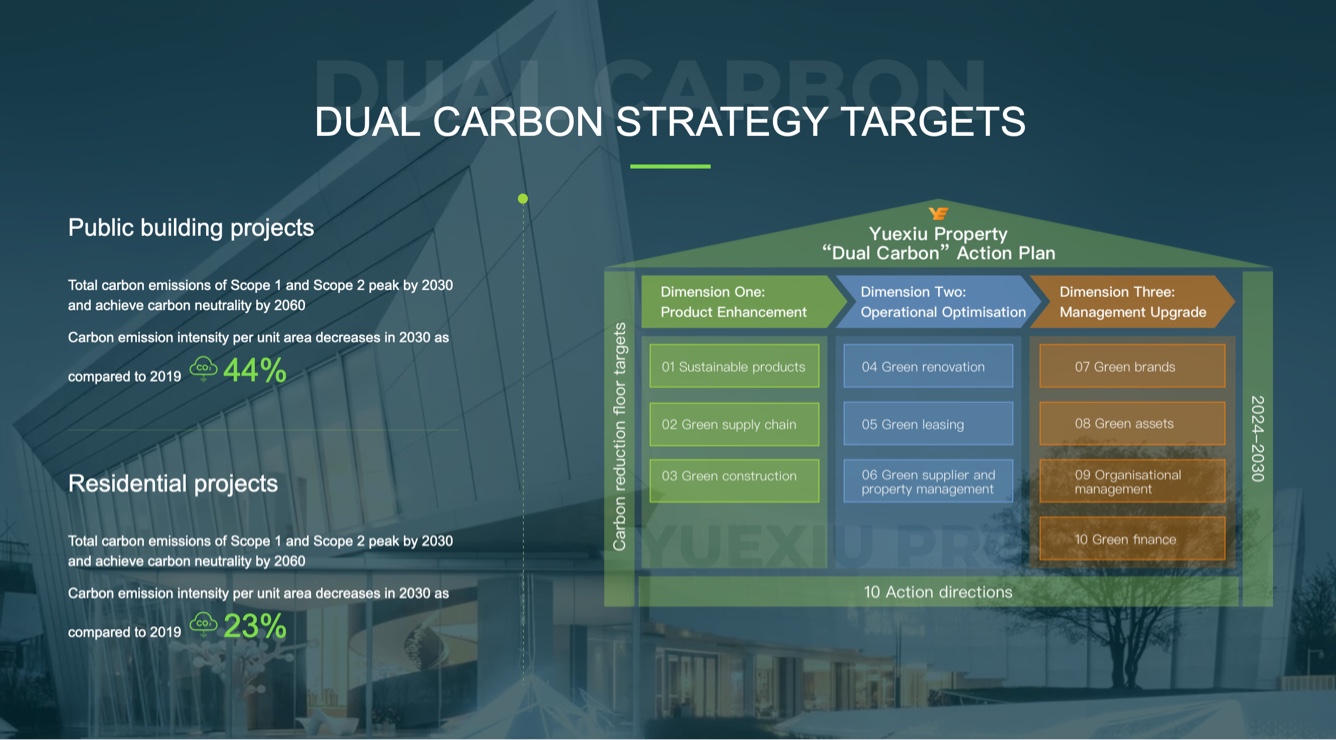Based on the country's "3060" dual-carbon target, Yuexiu Property firstly disclosed its carbon reduction targets in April this year in its ‘2023 Environmental, Social and Governance Report’: to achieve net-zero emissions target in the value chain by 2060, to reach carbon peak by 2030; and to reduce carbon emission intensity of Scope 1 and Scope 2 units of public building and residential projects by 44 percent and 23 percent respectively compared with 2019.

To share the company's latest achievements and progress in low-carbon buildings with stakeholders in a timely manner, Yuexiu Property added a new module of "Low-carbon Buildings" to the "Sustainability Section" of its official website in May this year, showcasing the company's use of technology and case studies in the field of low-carbon buildings.

Low Carbon Building Module in the Sustainability Section of Yuexiu Property's Official Website
The construction sector is one of the major areas of energy consumption and carbon emission in China, and accelerating the promotion of energy saving and carbon reduction in the construction sector is of great significance to achieving carbon peak and carbon neutrality and promoting high-quality development. Yuexiu Property uses buildings as a carrier to implement the concepts of near-zero-energy buildings and zero-carbon building design, and ultimately realises zero-carbon emissions during the operation phase through the adoption of renewable energy sources, high-efficiency energy systems and sustainable materials, so as to practically lead the way in green and low-carbon demonstration.
In order to standardise the information management of low-carbon building projects within the company, Yuexiu Property used digital technology to add a new module of "Low-carbon Project Management" to the "ESG Management System" on 12 June 2024, with the aim of helping the company to collect and manage information on low-carbon projects and certification, ensuring data completeness, accuracy and standardisation, while keeping abreast of the company's low-carbon building development and adjusting its development strategy, so as to ultimately promote the company's "dual-carbon" goal.

As of June 2024, Yuexiu Property has cumulatively designed or constructed 208 projects in compliance with green building standards, with floor area of 37,473,000 square metres, of which 4 are LEED Gold certified, with a certified area of 980,000 square metres; 19 projects in compliance with the three-star standard for green buildings and floor area of 4,292,000 square metres; 77 projects in compliance with the two-star standard for green buildings and floor area of 14.21 million square metres; 83 projects in compliance with the one-star green building standard and floor area of 12.40 million square metres; 25 projects in compliance with the basic green building standard, and floor area of 5.59 million square metres. Cumulatively, 14 ultra-low-energy buildings, 4 near-zero-energy buildings and 1 zero-energy building have been designed or constructed.
In the future, Yuexiu Property will continue to actively promote the implementation and certification of green buildings: by 2025, it will endeavour to ensure that 100% of all newly-built projects will be certified as one-star green buildings, and by 2030, it will endeavour to achieve 100% of all newly-built projects will be certified as two-star green buildings. Adhering to the core of green and healthy buildings featuring by "respect for nature, people-oriented, healthy and comfortable, intelligent and low-carbon", Yuexiu Property is committed to build a sustainable property for the full building lifecycle, and actively promoting the development and innovation of green buildings. Yuexiu Property will vigorously develop ultra-low-energy buildings, near-zero-energy buildings and double-zero-energy buildings, establish a low-carbon energy-consumption building system, continuously improve the level of energy conservation and carbon reduction, improve the quality of buildings, provide customers with green, low-carbon and healthy residential and commercial products, and contribute to the carbon peak and carbon neutrality of the construction sector.
